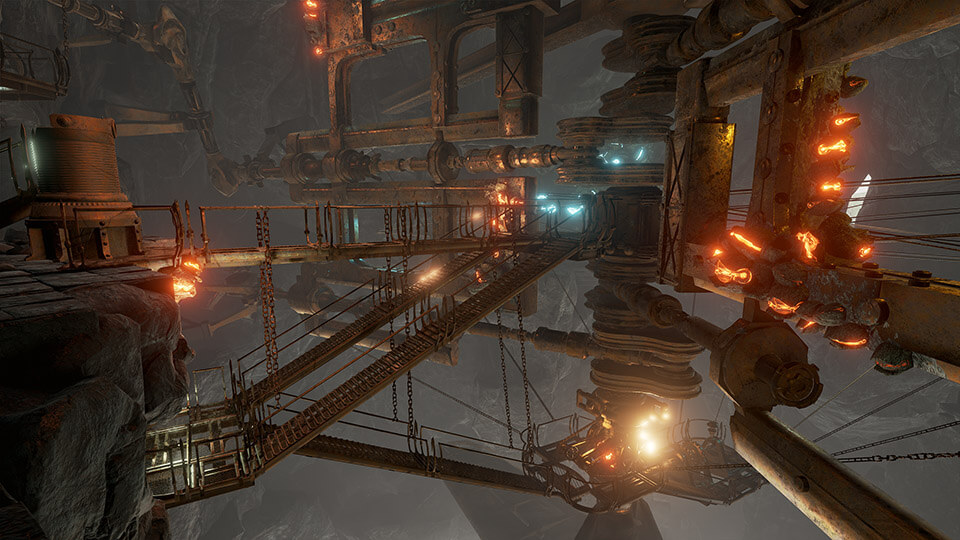With enormous, colorful landscapes and challenging puzzles, Obduction is a strong followup to developer Cyan’s previous games, including Myst and Riven. For some reason, we didn’t get our hands on a copy when Obduction launched on Steam last year. Nevertheless, I was thrilled when they released a PS4 version a couple weeks ago. When I was a kid, I’d stay up late playing Riven on our family PC with my mom. Whenever I tell her about a cool new game I’m playing now, she always asks me, “Would I like it? Is it like Riven?” Obduction has big shoes to fill.
When the game opens, you find yourself plucked from a wooded camp site and placed into a strange, dusty town. There’s no notice. No reason. It’s up to you to figure out what happened and how to get back home. You aren’t the first person to be dropped into town though. The strange major has prepared for visitors like you by placing half a dozen projection machines around the area. His distorted, static-filled FMV messages are reminiscent of those found in Myst’s red and blue books. However, these FMV sequences are incorporated into Obduction seamlessly and thoughtfully. They don’t feel outdated.

As another tribute to fans of former Cyan games, Obduction lets you choose your navigation style. The Point-and-Click option allows you to play in the same style as Myst. You simply face forward and click to move in that direction or turn around. However, a Free Roam option lets you wander around in any direction you like. I felt those warm fuzzies return when I played the first few minutes in Point-and-Click mode, but I was glad Free Roam was an option. I quickly switched over to the faster, smoother mode when my modern lack of patience got the best of me.
The game feels mysterious and ominous the entire time. I could absolutely picture myself alone in the world of Hunrath. Composers Robyn Miller and Hannah Gamiel nail the high-tension moments with perfectly-timed music. Obduction starts out strong, with challenging puzzles and fascinating places to explore. As in previous Cyan games, the detail is immaculate. Not only can you listen to eerie voice recordings of other people who had been dropped into the strange town, but you can read through pages of research. It all comes together to create a powerful, immersive experience.

When it comes to controls, the PS4 release of Obduction can be frustrating at times. Connect-the-dots puzzles that would be as simple as clicking and dragging on PC do not work as well on a handheld controller. When traveling across town by minecart, rail switches must be used to move over to a different set of tracks. Because of the way the minecart controls are bound, you have to select these switches with “X” and move them with the right joystick – an action that would be easier with two right thumbs. You can avoid the issue by climbing out of the cart, but this adds unnecessary time. These puzzles and mechanics seem better fit for the PC version of the game.
As with other Cyan games, Obduction provides you with the opportunity to teleport to exotic new worlds. Unfortunately, any excitement about traveling to these areas is short lived. About 75% of the way through the game, the moderate-but-optimistic pace comes to a halt. You must teleport objects to another world, rotate them, then teleport them back. This series of puzzles is a wonderful, challenging idea in theory. However, the loading time between worlds does not balance with the amount of time you spend between these teleportations. At launch, it often took several minutes for the PS4 to load the next area. This meant that I would spend 2-3 minutes waiting for the world to load, only a few seconds clicking a button to rotate the object, and then another 2-3 minutes traveling back. Having to do this once or twice might have been okay, but one of these teleportation puzzles requires at least eight back-to-back travels in a row. And that’s if you get it all right on the first try. Since then, the development team has patched the game a couple of times. The loading times have improved, but they still significantly slow down this part of the game and make it hard to stay interested in pushing through.

Obduction is nearly an atmospheric masterpiece, and I wish I could score it 10/10. The worlds are stunning, detailed, and believable. The soundtrack ties in perfectly and adds just the right amount of pacing and tension. Nevertheless, the fact that the game comes to a halt at the teleportation puzzles makes a significant impact on gameplay. With my first three days in the Obduction world, you couldn’t pull me away from the game. I was captivated and in love with something that was effortlessly pulling me back to the wonder of my childhood. Once I started having to wait for the game more than play it, I began to lose interest. This is something that may not be as big of an issue on PC, and they may release additional patches to improve loading times. If you have the patience to push through the small patch of hiccups, the game is absolutely worth your time.
Obduction is out now on PS4 and Steam (PC/Mac). You can also explore the game in VR (Oculus Rift/HTC Vive). A PSVR update will be coming soon. We had a chance to try Obduction VR for just a few minutes at PAX West and were impressed by how enormous the environments felt.
A PS4 review copy of Obduction was provided by Cyan for the purpose of this review


























































